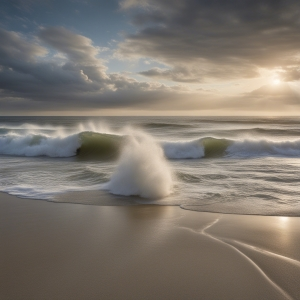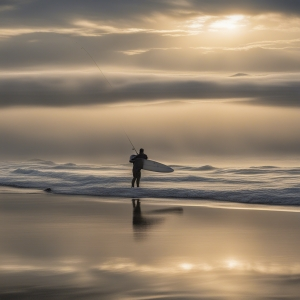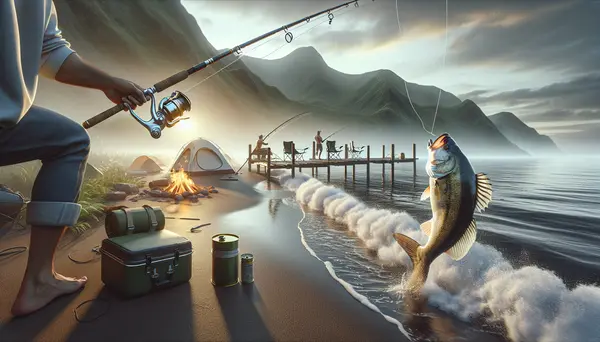Table of Contents:
Introduction to Surf Fishing Techniques
Consider the thrill of standing on the shore, your line cast far out into the swelling waves, and feeling that sharp tug signifying you've snagged a big catch. This is the essence of surf fishing - a popular and exciting form of angling that is surprisingly accessible, even for beginners. In this article, we will explore several effective surf fishing techniques designed to maximise your chances of reeling in those big ones by the shore. Whether you are a complete newbie or looking to hone your skills, there's a wealth of knowledge waiting for you here.
Let's delve into the surf and begin our fishing adventure!
Understanding the Basics of Surf Fishing
Before you strap on your fishing gear and head out towards the waves, it's important to grasp the critical basics of surf fishing. At its core, surf fishing involves casting a line from the shore and hoping for a catch from the deep sea. Ideal spots for this angling method include sandy beaches, rocky shores, and fishing piers. Knowing the best time for surf fishing plays a crucial part in gaining success as fish are usually more active during sunrise and sunset.
But, don't let this simplicity fool you! Surf fishing is an intricate dance that considers factors like tides, weather, bait selection and casting techniques. It requires you to learn about and respect the ocean and its inhabitants. So, let's take a closer look at these finer points.
Pros and Cons of Shore Fishing Techniques
| Technique | Pro | Con |
|---|---|---|
| Bait Fishing | Can attract a wide variety of fish species | May need to constantly replenish bait |
| Lure Fishing | Can be more engaging as it often involves casting and reeling | Larger fish may be more difficult to attract |
| Fly Fishing | Allows for precise control and presentation of the bait | Requires skilled casting technique and often expensive gear |
| Spear Fishing | Provides the ultimate skin-to-scale experience | Not for everyone, can be very challenging |
Choosing the Right Gear for Surf Fishing

Investing in the appropriate surf fishing gear can make a notable difference in your fishing experience. Let’s talk about the main components you need to consider:
Surf Fishing Rods: The Rod is your key tool in this fishing technique therefore it’s important to choose a durable, long rod to handle heavy weights and cast far out into the surf. Rods typically range from 9 to 15 feet are best for this purpose.
Fishing Line: A strong and good-quality fishing line is vital in surf fishing. Braided lines can withstand the harsh conditions and offer low friction for long casts.
Baits: Live or cut bait are standard choices for surf fishing. Sand fleas, shrimp, and cut pieces of fish like mullet or menhaden are excellent bait options.
Tackle: Your tackle box for surf fishing should include pyramid sinkers, hooks of varied sizes and possibly a fish-finder rig set.
Remember, choosing suitable gear is half the job done in surf fishing. Prepare wisely and enhance your chances of success.
Mastering the Art of Casting in Surf Fishing
The art of casting is a crucial skill to master in surf fishing. The goal is to get your bait as far out into the surf as possible, where the bigger fish tend to roam. Here are a few simple steps to improve your casting:
Positioning: Stand with your feet shoulder-width apart, left foot forward if you're right-handed, and vice versa. Your body should face the direction of the cast. Make sure you have a good balance, as this can significantly affect your cast strength.
Grip: Hold the rod firmly but not too tightly. Your right hand should be down the grip for power and your left hand close to the reel for control.
Backswing: Bring the rod tip back over your dominant shoulder, making sure you watch the tip so it doesn't catch on anything.
Casting: While looking out to your target, swiftly swing the rod forward. Release the line as the rod comes to the end of the casting movement. The timing of this release is key to achieving maximum distance.
Remember, practice makes perfect when it comes to casting in surf fishing. With time and patience, you'll gain greater accuracy and distance in your casts, making you a formidable surf angler.
Identifying the Best Fishing Spots at the Shoreline

One of the most significant factors in successful surf fishing is choosing the right location. Not all areas of the shoreline are created equal when it comes to attracting marine life. So, how do you identify the best spots?
Look for Cuts and Troughs: Areas where waves break far out often indicate a shallow sandbar with deeper water, or troughs, closer to shore. Fish often feed in these troughs, making them excellent spots for surf fishing.
Observe the Waves: Breaking waves stir up the sea bed, dislodging small creatures that larger fish feed on. Areas with more wave activity are likely to attract more fish.
Seek Local Advice: No one knows the shore better than local anglers or bait shop employees. Don't hesitate to ask for advice about the best fishing spots.
Patience and Observation: Invest your time in understanding your surrounding environment. Keep an eye on birds diving into the water or other signs of fish activity. The shoreline is ever-changing, and being observant can lead you to the best fishing spots.
Remember, understanding and adapting to the shoreline's dynamic environment is the key to successful surf fishing.
Key Surf Fishing Techniques to Catch Big Fishes
Now that we have covered the fundamentals, let's delve deeper into some winning strategies used by successful surf fishers to lure in the big catches from the shore.
Fish-Finder Rig: This is an effective rig setup for surf fishing. It allows your bait to move naturally with the currents and makes it more enticing to passing fish. You can purchase pre-made fish-finder rigs or create your own with a sliding sinker, swivel, leader, and a hook.
High-Low Rig: Also known as a double dropper loop, this rig allows you to use two baits suspended at different depths. This increases your odds of attracting your desired catch.
Tide Timing: Fish often feed more during the changing tides, so timing your fishing trips to correspond with high tide or falling tide can substantially increase your chances of catching fish.
Night Fishing: Many fish species feed more actively at night. As such, venturing out on well-lit nights with clear moons can prove rewarding.
Chumming: This entails using a mixture of grounded or cut fish parts and other food to attract fish to your fishing area. However, remember to comply with local guidelines and regulations regarding chumming practices.
These surf fishing techniques will improve your odds of netting the more significant species lurking in the surf. Remember that patience is the key - don't be disheartened by initial failures, stick with it, and you will see improvements over time.
Dealing with Challenges in Surf Fishing

Surf fishing is an adventure that brings great joy and thrill. However, it's not without its own set of challenges. These can range from dealing with unpredictable weather to handling the powerful pull of a big fish. Let's decipher how to deal with these challenges effectively.
Weather Changes: Weather can change quickly when you are fishing on the coast. Pack some extra clothing to deal with sudden temperature drops or rain. Keep an eye on weather forecasts and be prepared to adjust your plans if necessary.
The Powerful Pull: Landing a big fish from the surf can be physically demanding. Maintain a firm grip on your rod, keep your balance, and let the reel's drag do the work. Understand that the fish may run several times before it is tired enough to land.
Knotty Situations: Surf fishing often encounters inconvenient knots and tangles. This is where a good pair of pliers, a hook remover, and a sharp knife come in handy. Remember to carry these essentials in your gear box.
Crafty Predators: Occasionally, bigger predators may try stealing your catch while you're reeling it in. While there's little you can do to prevent this, being aware and prepared for such situations can help.
By addressing these and other challenges head-on, you can make your surf fishing experience much more rewarding and enjoyable. Always remember the saying - A smooth sea never made a skilled angler. Embrace the challenges and celebrate the growth in your fishing abilities.
Conclusion: Taking Surf Fishing to the Next Level
Through mastering the basics of surf fishing, including understanding tides and weather, using the right gear, and being thoughtful about bait and casting techniques, you are well on your way to becoming an accomplished surf angler. From identifying active fish feeding areas to mastering the flow and rhythm of your cast, there is a whole exciting world to explore in this satisfying and challenging form of fishing.
Moving forward, the key to transforming yourself from a beginner to a seasoned surf angler lies in practice. Spend as much time as you can at the shore, observing the ocean’s movements, practicing your casting techniques, and honing your ability to find the ideal spot for pitching your bait. Immerse yourself in the unique environment that surf fishing offers and build a relationship with the ocean and its resourceful inhabitants.
The true essence of surf fishing becomes evident once you embrace the thrill of the catch, the satisfaction of learning about life beneath the waves, and the tranquility of being one with the sea. Truly, there is nothing quite like casting a line at sunrise, watching the bait disappear into the deep, and feeling the anticipation of the great catch. Go out there and embrace all the opportunities surf fishing has to offer.
FAQs on Successful Surf Fishing Techniques
What is surf fishing?
Surf fishing is the sport of catching fish standing on the shoreline or wading in the surf.
What equipment is needed for surf fishing?
Basic surf fishing equipment includes fishing rods, fishing reels, bait, hooks, weights, and fishing line.
When is the best time to go surf fishing?
The best times for surf fishing are usually early morning or late evening because fish are more active during these times.
What types of fish can I catch when surf fishing?
Surf fishing can result in a variety of species, including bass, bluefish, sharks, and many more.
What are some surf fishing techniques to catch big fish?
Strategies for catching big fish include fishing during high tide, using fresh and local bait, casting beyond the breaking waves, and being patient.







